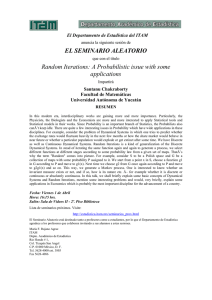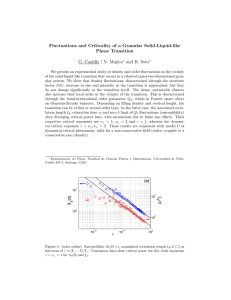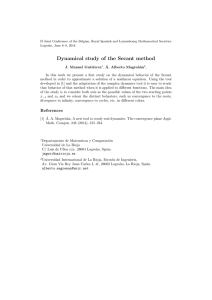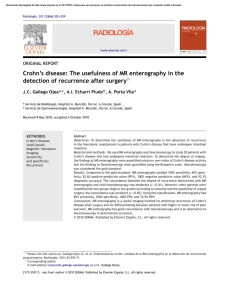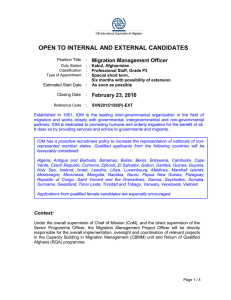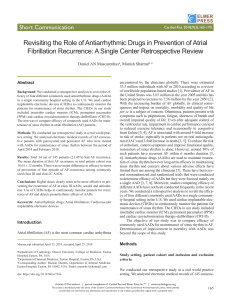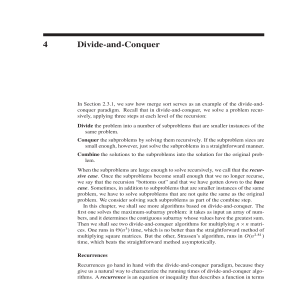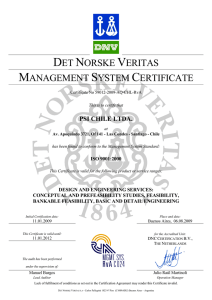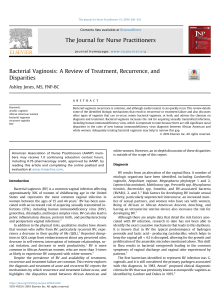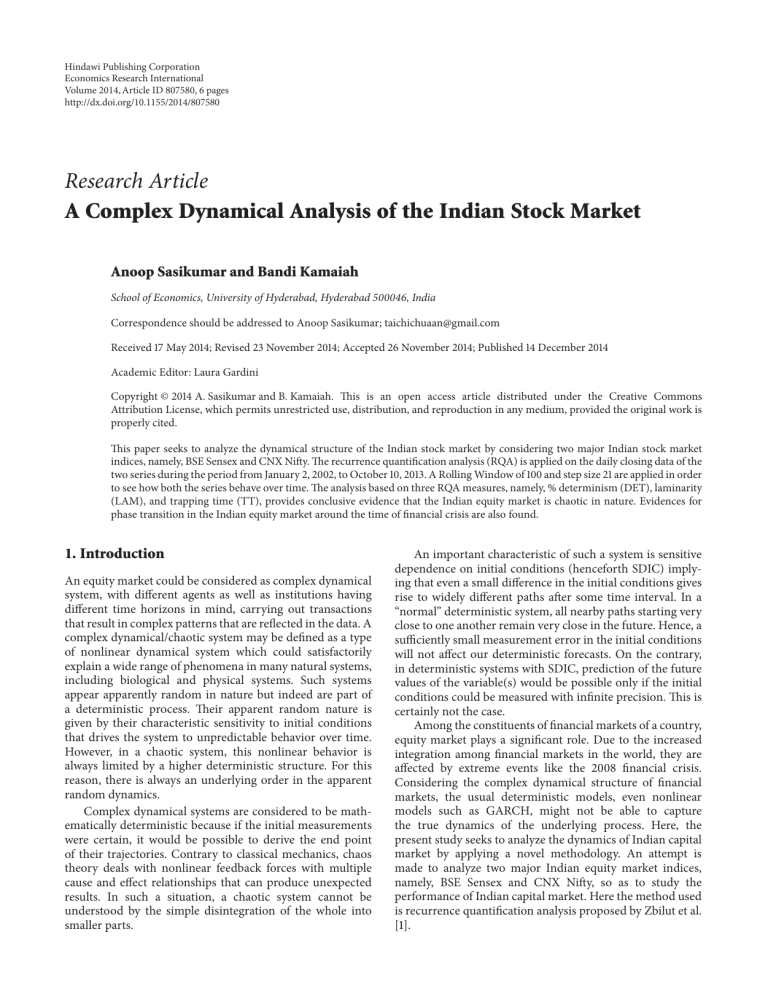
Hindawi Publishing Corporation
Economics Research International
Volume 2014, Article ID 807580, 6 pages
http://dx.doi.org/10.1155/2014/807580
Research Article
A Complex Dynamical Analysis of the Indian Stock Market
Anoop Sasikumar and Bandi Kamaiah
School of Economics, University of Hyderabad, Hyderabad 500046, India
Correspondence should be addressed to Anoop Sasikumar; taichichuaan@gmail.com
Received 17 May 2014; Revised 23 November 2014; Accepted 26 November 2014; Published 14 December 2014
Academic Editor: Laura Gardini
Copyright © 2014 A. Sasikumar and B. Kamaiah. This is an open access article distributed under the Creative Commons
Attribution License, which permits unrestricted use, distribution, and reproduction in any medium, provided the original work is
properly cited.
This paper seeks to analyze the dynamical structure of the Indian stock market by considering two major Indian stock market
indices, namely, BSE Sensex and CNX Nifty. The recurrence quantification analysis (RQA) is applied on the daily closing data of the
two series during the period from January 2, 2002, to October 10, 2013. A Rolling Window of 100 and step size 21 are applied in order
to see how both the series behave over time. The analysis based on three RQA measures, namely, % determinism (DET), laminarity
(LAM), and trapping time (TT), provides conclusive evidence that the Indian equity market is chaotic in nature. Evidences for
phase transition in the Indian equity market around the time of financial crisis are also found.
1. Introduction
An equity market could be considered as complex dynamical
system, with different agents as well as institutions having
different time horizons in mind, carrying out transactions
that result in complex patterns that are reflected in the data. A
complex dynamical/chaotic system may be defined as a type
of nonlinear dynamical system which could satisfactorily
explain a wide range of phenomena in many natural systems,
including biological and physical systems. Such systems
appear apparently random in nature but indeed are part of
a deterministic process. Their apparent random nature is
given by their characteristic sensitivity to initial conditions
that drives the system to unpredictable behavior over time.
However, in a chaotic system, this nonlinear behavior is
always limited by a higher deterministic structure. For this
reason, there is always an underlying order in the apparent
random dynamics.
Complex dynamical systems are considered to be mathematically deterministic because if the initial measurements
were certain, it would be possible to derive the end point
of their trajectories. Contrary to classical mechanics, chaos
theory deals with nonlinear feedback forces with multiple
cause and effect relationships that can produce unexpected
results. In such a situation, a chaotic system cannot be
understood by the simple disintegration of the whole into
smaller parts.
An important characteristic of such a system is sensitive
dependence on initial conditions (henceforth SDIC) implying that even a small difference in the initial conditions gives
rise to widely different paths after some time interval. In a
“normal” deterministic system, all nearby paths starting very
close to one another remain very close in the future. Hence, a
sufficiently small measurement error in the initial conditions
will not affect our deterministic forecasts. On the contrary,
in deterministic systems with SDIC, prediction of the future
values of the variable(s) would be possible only if the initial
conditions could be measured with infinite precision. This is
certainly not the case.
Among the constituents of financial markets of a country,
equity market plays a significant role. Due to the increased
integration among financial markets in the world, they are
affected by extreme events like the 2008 financial crisis.
Considering the complex dynamical structure of financial
markets, the usual deterministic models, even nonlinear
models such as GARCH, might not be able to capture
the true dynamics of the underlying process. Here, the
present study seeks to analyze the dynamics of Indian capital
market by applying a novel methodology. An attempt is
made to analyze two major Indian equity market indices,
namely, BSE Sensex and CNX Nifty, so as to study the
performance of Indian capital market. Here the method used
is recurrence quantification analysis proposed by Zbilut et al.
[1].
2
2. Literature Review
Application of recurrence quantification analysis (RQA) in
the field of financial markets is of recent origin. Hence there
are only few studies available in the literature applying this
methodology to financial markets, especially equity markets.
Here, we present a quick review of the available studies.
Guhathakurta et al. [2] studied three equity markets,
namely, Nifty, Hong Kong AOI, and DJIA, using the RQA.
They mainly employed recurrence plots (RP) to capture
endogenous market crashes and found evidences for phase
transitions before the occurrence of a market crash. Using
the same methodology, Bastos and Caiado [3] analyzed the
presence of complex dynamical structure in international
stock markets. Their results suggest that the dynamics of
stock prices in emerging markets is characterized by higher
values of RQA measures when compared to their developed
counterparts. They analyzed the behavior of stock markets
during extreme financial events, such as the burst of the
technology bubble, the Asian currency crisis, and the recent
subprime mortgage crisis, using RQA in sliding windows.
It is shown that during these events stock markets exhibit
a distinctive behavior that is characterized by temporary
decreases in the fraction of recurrence points contained
in diagonal and vertical structures. Similarly, Bigdeli et
al. [4] analyzed the dynamical properties of Iranian stock
prices using recurrence quantification analysis along with
other methods. They found evidences of seasonality and
nonstationarity in the data analyzed. The results confirmed
presence of chaotic behavior in the Iranian equity market.
O. Piskun and S. Piskun [5] studied various stock market
crashes, such as DJI 1929; DJI, NYSE, and S&P500 1987;
NASDAQ 2000; HSI 1994, 1997 and Spanish 1992, Portuguese
1992, British 1992, German 1992, Italian 1992, Mexican 1994,
Brazilian 1999, Indonesian 1997, Thai 1997, Malaysian 1997,
Philippine 1997, Russian 1998, Turkish 2001, Argentine 2002,
and the 2008 financial crisis, and discussed the use of the
measure “laminarity” to identify market bubbles. In a recent
study, Moloney and Raghavendra [6] examined the DJIA
using RQA and found evidences for phase transitions as
the markets move from Bull to Bear state. There were also
evidences for a nondeterministic regime when the market
reaches its peaks. The authors used noise trader theory to
support the findings.
From the available literature, it is evident that the RQA
could be useful in capturing the dynamical properties of
an equity market. A comprehensive study on the dynamical
nature of the Indian equity market is yet to be carried out
to the best of the author’s knowledge. The present study
positions itself in this direction. The remainder of this paper
is organized as follows. Section 3 presents the data and
methodology used. Section 4 provides the empirical analysis
and concluding remarks are given in Section 5.
3. Data and Methodology
Two major indices from the Indian capital markets, that is,
CNX Nifty and BSE Sensex, are selected. Daily closing data
from January 2, 2002, to October 10, 2013, are collected and
Economics Research International
used for the purpose of analysis. To avoid scale difference,
we apply a logarithmic transformation to both series. To
analyze the dynamical structure, we apply the RQA developed
by Zbilut et al. [1]. RQA is essentially quantification of
the recurrence plots developed by Eckmann et al. [7]. It is
employed to analyze the dynamical structure of a time series
based on the property of recurrence. RQA provides various
measures that could explain the dynamical nature present in
the data. Here, a Rolling Window RQA is proposed so as
to capture the time varying dynamics of the Indian capital
market indices. Three RQA estimates, namely, percentage
determinism (DET), laminarity (LAM), and trapping time
(TT), are calculated using a Rolling Window.
3.1. Recurrence Quantification Analysis. The RQA method
which is used in the study consists of two parts: the recurrence
plot (RP) developed by Eckmann et al. [7], a graphical
tool that evaluates the temporal and phase space distance,
and recurrence quantification analysis (RQA), a statistical
quantification of RP. The basic idea of the RP is that, in a
chaotic system, the nearby trajectories visit the same points
in the phase space repeatedly. Here, the closeness is measured
by a critical radius. A recurrence plot is used to show this
behavior graphically. The advantage of the RP is that it
could provide an adequate visual representation of a process
that happens in the 𝑚-dimensional phase space in a twodimensional plot.
Let {𝑋𝑡 } be a time series whose trajectories are orbiting
in the phase space. If the orbit is one period, the trajectory
will return to the neighbourhood of {𝑋𝑡 } after an interval
equals 1; if the orbit is two periods, it will return after an
interval equals 2, and so on. Therefore, if {𝑋𝑡 } evolves near a
periodic orbit for a sufficiently long time, it will return to the
neighbourhood of {𝑋𝑡 } after some interval (𝑇). The criterion
of closeness requires that the difference |𝑋𝑡 − 𝑋𝑖+𝑇 | be very
small.
Computing differences |𝑋𝑡 − 𝑋𝑡+𝑖 |, where 𝑡 = 1, . . . , 𝑛,
𝑖 = 1, . . . , 𝑛 − 1, and 𝑛 is the length of sample, the close return
test detects the observations for which |𝑋𝑡 − 𝑋𝑖+𝑇 | is smaller
than a threshold value 𝜀. 𝑋𝑡 is plotted against 𝑋𝑖+𝑇 to observe
the patterns. If the data is i.i.d., the distribution of points will
be random. If the time series is deterministic, it is possible to
observe horizontal line segments.
Recurrence plots are symmetrical over the main diagonal.
It is based on the reconstruction of time series and an estimation of the points that are close. This closeness is measured
by a critical radius so that a point is plotted as a colored pixel
only if the corresponding distance is within this radius. The
line segments (diagonals) parallel to main diagonal are point
that move successively closer to each other in time and would
not occur in random. Chaotic behavior produces very short
diagonals, whereas deterministic behavior produces longer
diagonals. Thus, if the analyzed time series is chaotic, then
the recurrence plot shows short segments parallel to the main
diagonal; on the other hand, if the series is white noise, then
the recurrence plot does not show any kind of structure.
RP may be explained with the help of the examples given
in Figure 1.
Economics Research International
3
(a)
(b)
(c)
(d)
Figure 1: (a) Homogeneous (uniformly distributed noise), (b) periodic (superpositioned harmonic oscillations), (c) drift (logistic map
corrupted with a linearly increasing term), and (d) disrupted Brownian motion. Figure taken from http://www.recurrence-plot.tk/glance.php.
The first RP is created from an i.i.d. noise. We can see
that there are no discernable patterns. The next plot is created
from a periodic time series. Here, we can see patterns in the
plot corresponding to the nature of the data. The third plot
is created from a logistic time series with a drift. Here we
can see that it is different from the first two. Here, the drift
is used to simulate systems with slowly changing parameters.
Correspondingly, the upper left and lower right corners of RP
are brightened. The fourth RP is estimated from simulated
disrupted Brownian motion time series, in order to explore
and capture abrupt changes in a system. Here, the extreme
events are characterized by white bands/areas in the plot.
From the above example, we can understand that recurrence plots can be quite useful in analyzing the dynamical
properties of a time series. However, visual interpretation
of such a plot could be difficult at times and may not yield
conclusive results always. Hence, Zbilut et al. [1] proposed
a statistical quantification of RP, which is the well-known
recurrence quantification analysis (RQA).
The RQA was developed in order to quantify differently
RPs based on the small-scale structures therein. Recurrence
plots contain single dots and lines which are parallel to
the mean diagonal (line of identity, LOI) or which are
vertical/horizontal. Lines parallel to the LOI are referred to
as diagonal lines and the vertical structures as vertical lines.
Whereas the diagonal lines represent such segments of
the phase space trajectory which run parallel for some time,
the vertical lines represent segments which remain in the
same phase space region for some time. The RQA quantifies
the small-scale structures of recurrence plots, which present
the number and duration of the recurrences of a dynamical
system.
The measures introduced for the RQA were developed
during the period from 1992 to 2002 [8–10]. They are
actually measures of complexity. The main advantage of the
recurrence quantification analysis is that it can provide useful
information even for short and nonstationary data, where
other methods fail.
4
Economics Research International
In this study, three RQA measures, namely, (i) determinism, (ii) laminarity, and (iii) trapping time, are employed.
These measures are taken from Marwan et al. [11].
(1) Determinism (DET) is the ratio of recurrence points
forming diagonal structures to all recurrence points. DET
measures the percentage of recurrent points forming line
segments that are parallel to the main diagonal. A line segment is a point’s sequence, which is equal to or longer than a
predetermined threshold. Here, 𝑙 is the length of the diagonal
lines and 𝑃(𝑙) is the histogram of diagonal lines. These line
segments reveal the existence of deterministic structures
within the recurrence plot under analysis. Consider
DET =
𝜀
∑𝑁
𝑙=𝑙min 𝑙𝑃 (𝑙)
𝑚,𝜀
∑𝑁
𝑖,𝑗=1 R𝑖,𝑗
.
(1)
(2) Laminarity (LAM) is related to the amount of laminar
phases in the system (intermittency). It is estimated from the
amount of recurrence points which form vertical lines. Here
V implies the length of vertical lines and 𝑃(V) is the histogram
of vertical lines. Consider
LAM =
∑𝑁
V=Vmin V𝑃 (V)
∑𝑁
V=1 V𝑃 (V)
.
(2)
(3) Trapping time (TT) is related with the laminarity time
of the dynamical system, that is, how long the system remains
in a specific state. Consider
TT =
∑𝑁
V=Vmin V𝑃 (V)
∑𝑁
V=Vmin 𝑃 (V)
.
thereafter. This point roughly coincides with the collapse of
the Lehmann Brothers in USA, an event that is supposed
to have triggered the 2008 financial crisis. After this point,
the value of DET keeps fluctuating, and takes a dip around
the point 2000-2200, a period that coincides with the 2010
Euro zone debt crisis. This behavior indicates that Indian
stock markets remained in a state of turbulence after the
2008 financial crisis. Here, it is observed that the fluctuation
in DET in BSE Sensex is more than that of NSE Nifty. The
changes in DET give clear indication about the possibility of
a phase transition taking place in the Indian equity market.
We will examine this possibility further with the help of the
next measure.
The second measure that we analyzed is laminarity
(LAM). It gives an indication about the extent to which a
system stays in a particular state. For both the indices, there
was a relative stability before the 2008 crisis. However, the
value shows a drop around 2008 crisis. Here, we can see
evidences for phase transitions within the market from order
to chaotic behavior. After the 2008 crisis, it could be seen
that the market remained more or less in the chaotic phase
for a long term, during the recovery and due to the possible
impact from the 2010 Eurozone debt crisis. Towards the end
of the graph we could see that the markets are on their way to
recovery, indicated by the relatively stable values of LAM.
Trapping time (TT) gives an indication about the time for
which a system was “trapped” in a particular state. Here, the
value of TT drastically decreases after the point 1500 for both
the indices. It could be said that there was increased amount
of turbulence in the Indian equity market after the 2008 crisis.
(3)
In the above equation 𝑃(V) is the frequency distribution of the
lengths V of the vertical lines, which have at least a length of
Vmin .
While carrying out the analysis, two major parameters
that are to be determined are the embedding dimension 𝑚
and the time delay 𝑡. There are different opinions related to
the estimation of these two parameters. It is argued that 𝑚
and 𝑡 should be estimated using methods such as false nearest
neighbors and method of mutual information. Another point
of view is that it is possible to set 𝑚 = 𝑡 = 1 [12]. Zbilut [13]
suggests that a value of 𝑚 = 10 can capture the complexity of
a financial market while 𝑡 could be set to be 1 as the financial
data is discreet in nature. In this study, we follow the approach
suggested by Zbilut.
4. Discussion of Results
Here we apply a Rolling Window RQA with window length
100 and step length 21 to both series. Figure 2 shows the
RQA output of BSE Sensex while Figure 3 shows that of CNX
Nifty. After analyzing both outputs, some common trends are
visible.
After analyzing % deterministic structure (DET), it is
clear that the measure does not show many fluctuations till
the point 1000 for both the indices. But after that DET takes
a sudden dip around 1500 and remains in a turbulent state
5. Conclusions
The objective of this paper was to analyze the dynamical
behavior of the Indian capital market. For this purpose, two
major indices, namely, BSE Sensex and CNX Nifty, were
considered and daily closing data for the period from January
2, 2002, to October 10, 2013, was used in the analysis. We took
the help of dynamical systems method, namely, recurrence
quantification analysis (RQA), to capture the underlying
dynamical structure of both markets. We applied a Rolling
Window RQA to both the series in order to capture the time
varying dynamics of both the indices.
From the RQA measures, it was evident that the Indian
capital market was affected by the 2008 financial crisis as
well as the 2010 Eurozone debit crisis. The analysis was
able to capture phase transitions from order to chaos within
the market prior to the crisis period. Hence, recurrence
quantification analysis could be used as an early warning
system to spot market turbulences.
The results from this study are in line with the previous
works that employed RQA to study equity markets. The
dynamical nature of the market was confirmed through
various measures. Further, transition of the market from
one phase to another prior to an extreme event could be
successfully captured as well like in the previous studies.
5
2
0.2
1
0.15
Variance
Data
Economics Research International
0
−1
−2
0
1000
2000
0.05
0
3000
1
1
0.98
0.95
LAM
0.96
DET
0.1
0.94
0.8
0.75
2000
3000
2000
3000
0
1000
2000
3000
0.9
0.9
1000
1000
0.85
0.92
0
0
100
TT
80
60
40
20
0
1000
0
2000
3000
2
0.2
1
0.15
Variance
Data
Figure 2: Rolling Window RQA output for BSE Sensex.
0
−1
−2
0
1000
2000
0
3000
1000
2000
3000
0
1000
2000
3000
0.95
0.95
LAM
DET
0
1
1
0.9
0
1000
2000
TT
0.85
0.1
0.05
100
80
60
40
20
0
0
3000
1000
0.9
0.85
0.8
2000
3000
Figure 3: Rolling Window RQA output for NSE Nifty.
Contrary to the main-stream modeling paradigm that
depicts the financial markets as an informational efficient system in equilibrium, it was proven here that they
are a nonequilibrium type of complex dynamical system.
There are regions of stability, followed by phases of instability. While RQA could be used as an early warning
system to identify the possibility of a financial crisis, further research is needed in the development of investment
6
models with underlying assumptions about the dynamical
behavior of a market. Real time application of such models for investment purposes may help the market achieve
stability.
Appendix
See Figures 2 and 3.
Conflict of Interests
The authors declare that there is no conflict of interests
regarding the publication of this paper.
References
[1] J. P. Zbilut, A. Giuliani, and C. L. Webber Jr., “Recurrence
quantification analysis as an empirical test to distinguish relatively short deterministic versus random number series,” Physics
Letters A: General, Atomic and Solid State Physics, vol. 267, no.
2-3, pp. 174–178, 2000.
[2] K. Guhathakurta, B. Bhattacharya, and A. Roy Chowdhury,
“Analysing financial crashes using recurrence plot—a comparative study on selected financial markets,” in Forecasting
Financial Markets in India, R. P. Pradhan, Ed., pp. 22–29, Allied
Publishers Delhi, New Delhi, India, 2009.
[3] J. A. Bastos and J. Caiado, “Recurrence quantification analysis
of global stock markets,” Physica A: Statistical Mechanics and its
Applications, vol. 390, no. 7, pp. 1315–1325, 2011.
[4] N. Bigdeli, M. Jafarzadeh, and K. Afshar, “Characterization of
Iran stock market indices using recurrence plots,” in Proceedings
of the International Conference on Management and Service
Science (MASS ’11), pp. 1–5, August 2011.
[5] O. Piskun and S. Piskun, “Recurrence Quantification Analysis
of Financial Market Crashes and Crises,” 2011, http://arxiv
.org/abs/1107.5420v1.
[6] K. Moloney and M. Raghavendra, “Examining the dynamical
transition in the Dow Jones industrial index from bull to
bear market using recurrence quantification analysis,” Working
Paper E. Cairnes School of Business and Economics Working
Paper Series 176, 2012.
[7] J. P. Eckmann, S. O. Kamphorst, and R. Ruelle, “Recurrence
plots of dynamical systems,” Europhysics Letters, vol. 4, no. 9,
pp. 973–977, 1987.
[8] J. P. Zbilut and C. L. Webber Jr., “Embeddings and delays as
derived from quantification of recurrence plots,” Physics Letters
A, vol. 171, no. 3-4, pp. 199–203, 1992.
[9] C. L. Webber Jr. and J. P. Zbilut, “Dynamical assessment of physiological systems and states using recurrence plot strategies,”
Journal of Applied Physiology, vol. 76, no. 2, pp. 965–973, 1994.
[10] N. Marwan, N. Wessel, U. Meyerfeldt, A. Schirdewan, and J.
Kurths, “Recurrence-plot-based measures of complexity and
their application to heart-rate-variability data,” Physical Review
E, vol. 66, no. 2, Article ID 026702, 2002.
[11] N. Marwan, M. Carmen Romano, M. Thiel, and J. Kurths,
“Recurrence plots for the analysis of complex systems,” Physics
Reports, vol. 438, no. 5-6, pp. 237–329, 2007.
[12] M. Thiel, M. C. Romano, P. L. Read, and J. Kurths, “Estimation of
dynamical invariants without embedding by recurrence plots,”
Chaos, vol. 14, no. 2, pp. 234–243, 2004.
Economics Research International
[13] J. P. Zbilut, “Use of recurrence quantification analysis in economic time series,” in Economics: Complex Windows, M.
Salzano and A. P. Kirman, Eds., pp. 91–104, Springer, Milan,
Italy, 2005.
